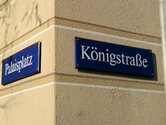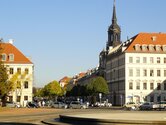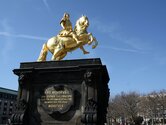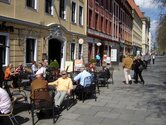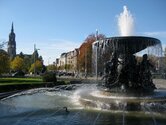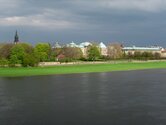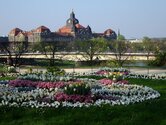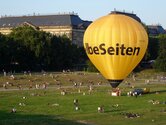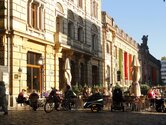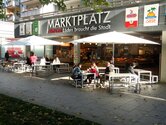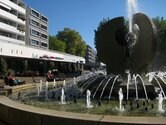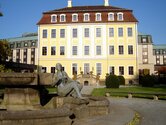Inner New City (Innere Neustadt Dresden)
The Inner New City is located opposite to the Inner Old City on the northern (and right) bank of the river Elbe. Only one bridge crossing interlinks both quarters. Thousands of visitors are crossing the Augustusbrücke bridge every day to discover the uniqueness of Dresden on both sides of the river. After a devastating fire in the town in the year 1685, that destroyed the whole building fabric on this side of the river Elbe, this quarter, called Altendresden (Olden Dresden) until 1732, had been re-erected in the style of baroque as New King’s Town (later shorter “Neustadt” – “New town” or "New City").
The Golden Horseman (Goldener Reiter)
The Golden Horseman on the Neustädter Markt is perhaps not the artistically most valuable, but the best-known memorial of Dresden. It is erected in the honour of August the Strong (1670 – 1733) as patron of the baroque construction of the King’s Town.
The Blockhaus
The name Blockhaus refers to both the cubic structural shape and the purpose of the building as guard house at the New Town end of the Augustusbrücke bridge. The original plan of a pyramid-shaped building that should carry the equestrian statue of August the Strong (1670 – 1733) on top of it was rejected. Instead of that the control and customs station moved in there in 1755. Today (spring 2021) the building is in reconstruction and after completion it will be the host of "archive of the avant-gardes", the collection of Egidio Marzona.
Hauptstraße
In the course of construction of the baroque New King’s Town August the Strong (1670 – 1733) commissioned to build a Via triumphalis between Neustädter Markt and current Albertplatz – the Hauptstraße (High Street). The avenue planted with lime trees was considered at its formation in the 18th century to be the most glamourous street of Dresden and up to the opening of Brühl’s Terrace to the public in the year 1814 to be the main promenade of the town. Today the Hauptstraße is a pedestrian boulevard shaded by sycamores decorated with sculptures and fountains, inviting to stroll and stay in one of our holiday apartments in Dresden city centre.
Craftspeople Passages Dresden
www.hauptsache-hauptstrasse.de
The Dreikoenigskirche Church
The Dreikönigskirche (Church of the Three Kings) finished in the year 1739 based on the design by Matthäus Daniel Poeppelmann (1662 – 1736) and George Bähr (1666 – 1738) is already the fourth chapel at this point. After the bombings in February 1945 the Dreikönigskirche burned out. Reconstruction as a churchly general-purpose building extended until 1994. In October 1990 the constituent meeting of the newly elected Saxon Parliament took place here. Today the church is a place for various events. The view of the tower offers the best glance at the Altstadt.
Albertplatz Square
The Albertplatz named after King Albert of Saxony (1828 - 1902) was designed according to the plans of the architect to the imperial court Gottlob Friedrich Thormeyer (1775 – 1842). In the 19th century Albertplatz was considered to be one of the most beautiful round places of Germany. Today the square equipped with plenty of green spaces is traffic junction of Dresden’s Neustadt (New town). The two twin fountains „Stille Wasser“ (Still Waters) and „Stürmische Wogen“ (Stormy Waves) casted in bronze are considered to be the most beautiful fountains of Dresden.
Koenigstraße
The Koenigstraße and the branching off Raehnitzgasse today are the most beautiful baroque streets of Dresden and the heart of the so-called Baroque Quarter. A multiplicity of completely individually arranged boutiques, designer shops, art galleries, and restaurants invite to stroll and discover. It was the task of the famous Baroque-master builder Matthäus Daniel Pöppelmann (1662 – 1736) to draft the Koenigstraße between the Japanese Palace (Voelkerkundemuseum – Museum of Ethnology) and Albertplatz. The Quarter on Rähnitzgasse, to the West of the Dreikönigskirche, survived the bombings of February 1945 leniently. Today it is the only preserved self-contained living ensemble of the middle-class Saxon Baroque architecture of Dresden and quite close to our vacation flats in Dresden Obergraben or in Heinrichstrasse street
The Japanese Palace
The Japanese Palace emerged from an in the year 1715 erected country house, also called the Dutch Palace. Under the site management of Pöppelmann (1662 – 1736) it was integrated into the side to the river Elbe of the building complex that was made a four-winged building between 1728 and 1737. August the Strong (1670 – 1733) intended to store his rich porcelain collection in the Japanese Palace. For his son and successor Friedrich August II. (1696 – 1763, called also „August the Fat“) however the collection was of less important representation value. After the death of August the Strong (1733) the Japanese Palace served as a museum. The now out of date baroque interior decoration of the festivity chambers was changed gradually into a museum interior. Today the Landesmuseum für Vorgeschichte (State Museum of Prehistory) and the Staatliche Museum für Voelkerkunde (Museum of Ethnology) are situated in the Japanese Palace.
Jaegerhof
Elector August of Saxony (1526 - 1586) had the Jägerhof built from the year 1569 with four wings to serve representative purposes of the electoral household. It was built on the spot of the Augustinian Cloister which was closed in the year 1539 after the entry of Reformation. During the 19th century the military used the Jaegerhof as barracks for the cavalry. After partial demolishing today only the west wing exists and since the year 1913 the Museum für Saechsische Volkskunst (Museum for Saxon Folk Art) has its domicile in the Jaegerhof.
Saxon Ministry Of Finance (Finanzministerium)
This at the construction period around 1890 very monumental and authoritarian, and for Saxony atypical style of construction was allowed by French reparations payments after the German – French War of 1870/71. After World War II intensive reconstruction was necessary and today the Saxon Ministry of Finance is residing in this house.

